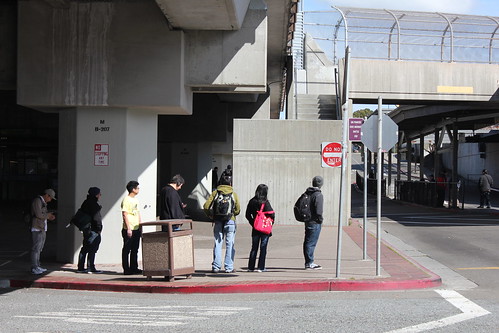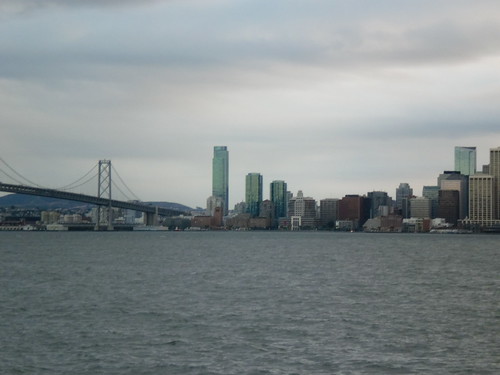She is sitting cross-legged on the wooden floor, leaning towards her long mirror as she carefully applies a thick coat of eyeliner. Katy Perry’s “California Gurls” is playing in her cave-like room. She grabs her black jacket, purse, and heads off for a night out with friends. She pulls her scooter from the garage to the driveway and when she turns it on, she realizes the meter is not working. “You’ve got to be kidding me,” Kaela PerLee says to herself. Annoyed, she makes her last attempt knowing in the back of her head that it is not going to work. In San Francisco, this would not come as a hastle as PerLee can easily catch public transportation almost anywhere within a short walking distance. Living in Daly City however, is another story. “Walking from my house to Daly City BART takes 20 minutes, and though the actual BART ride is not long, I have to make sure I head to a BART station before midnight to catch the last train out of San Francisco.” PerLee knows it is more of a drag going out at night, so she constantly reminds herself when to say goodbye and start making the long trip home.
PerLee moved from Santa Rosa to attend SF State University almost two years ago, and though it has been a new experience living away from home, she sometimes feels shortchanged not being able to live in actual San Francisco. With rent so high, many SF State students struggle to find an affordable place to live in the city. Whether it is Daly City or the East Bay, having to commute longer distances can get in the way of enjoying the active, lively environment of San Francisco. Some college students transfer or apply to SF State to experience the diverse lifestyle the city offers, along with its campus. Others, for certain reasons, reside outside the city. So are students really missing out on the experience of living in the city? Or is cheaper rent worth the longer walks, commutes and extra efforts?
Matthew Becerra remembers those tedious mornings when he lived in Daly City. He recalls having to walk up 87th Street, then down the long stretch of Junipero Serra where he walked over the same bridge, passed the same gas station, then the abandoned buildings and animal hospital that never seemed to be open. As the Century Theater sign got bigger, Becerra felt the long walk coming to an end as he reached BART, and left the dreadful fog of Daly City behind. “Because I lived on the border of Daly City and San Francisco, there was no MUNI nearby for me and so I had to walk to the BART station everyday to take the free shuttle,” says the 22-year-old SF State student. Now that he lives in Park Merced, it takes him a swift two minutes rather than two hours to get to class. “The convenience makes my life a lot easier in so many ways as I can plan my schedule and daily routine without worrying about how to get back to Daly City, seeing as how their public transportation seem to stop running around 8p.m.”
On the other hand, art education major, Heather Boyer, can handle the extra hours of commuting to SF State from Fremont all in effort of staying closer to family and friends. Like Bacerra, Boyer’s mornings start about three hours before class. She takes an hour to get ready, grabs a quick breakfast, then walks to Fremont BART, which takes around 15 to 20 minutes. It takes a little over an hour until Boyer makes it to Daly City BART where she catches the shuttle; her final commute to State. When Boyer plans to hang out in the city, she finds ways to save money and time by staying at a friends house and driving instead of relying on public transportation. Living outside of San Francisco doesn’t stop Boyer from enjoying the city living perks, but she does however, prefer Fremont’s weather and economic living. “I hate the prices of everything, like rent, parking, parking tickets and taxes. I dislike traffic and the busyness of life [in San Francisco] sometimes, but it depends on where you live,” says Boyer.
While people choose to make a home outside the city in hopes of saving some money, the cost of public transportation can still add up. Taking BART one way from any city outside of San Francisco to Powell Street is no less than $2.95, compared to the $1.75 spent commuting within San Francisco. MUNI has bus lines crossing any area within the city and offers a transfer that is valid for two hours for $2. As for San Mateo’s public transportation, the SamTrans runs only every half hour between certain times, depending on the day, and charges $2 without a transfer.
Michelle Dayrit a Fremont resident and newly transfer student spends $50 commuting from Fremont to San Francisco then to Berkeley (where she works) twice a week. But like Boyer, despite the traveling woes, Dayrit still prefers the quiet living environment Fremont offers.
Attending a school like SF State usually means that a good percentage of those commuter students do not depend on their parents, and have economic statuses where they have to work in order to pay for their own education. “I don’t qualify for financial aid and both my parents passed away, leaving me with no help from family. Therefore, I have to work full time and take out loans in order to attend SF State,” says Dayrit, 26, a communications major. “But I’m okay with it. They never said it would be easy, but they did say it would be worth it.” Having an ill father, Boyer also felt it was important to stay home to be there for her father, and help out with household expenses. When her father passed away, Boyer’s priority was to stay close to her family. Born and raised in the East Bay, Boyer does not feel the need to move to San Francisco as most of her friends and family live in Fremont while she can still commute to the city for school or to hang out.
In Becerra’s case, moving to San Francisco gave him a better opportunity to find a job, which compensates him having to spend more money. One of the greatest temptations of living in San Francisco, Becerra describes, is its vast variety of delicious local restaurants and bars conveniently located everywhere in the city. Which makes it easier for students like him to spend more money on dining out rather than taking the time to actually cook something. And even if cooking is an option, grocery shopping in the city is not cheap.
Commuting from the other side of the Golden Gate Bridge is mechanical engineering major, Jason Mehrens. Everyday, he spends about an hour in his car battling traffic, from Mill Valley in Marin County to SF State. For Mehrens, the disadvantage of living away from San Francisco is having to commute all the time. Whether it’s a school function or personal leisure in the city, driving is the easiest option. Mehrens lives with his parents to save money and has a tuition waiver through the Veterans Affairs office. Even with some financial assistance from the government, he still has to take out loans and work some hours in order to cover college costs, which leaves him with very little free time to spare. Having spent one year at Chico State then three years living in Santa Barbara working on his Associates Degree, Mehrens feels like he has already experienced college living. “I can’t make up my mind if I want to live in the city because I work in Marin,” says Mehrens. “If I worked in the city, then I would probably make the move, but I don’t like the feel of living in close proximity to thousands and thousands of people stacked on top of one another.” It is a hard trade given the miles of parks and rich forests Marin houses, or the serene atmosphere the county has to offer, as hours can go by without having to hear the loud noises of traffic and busy city people. For Bacerra, moving closer to campus has encouraged him to become active in campus life. He is trying to join the History Students Association and now finds himself having more time to attend sporting events since his commute time is cut significantly. But for others, like Dayrit and Mehrens, getting away from the city’s rowdiness is worth the extra miles and longer BART rides.




